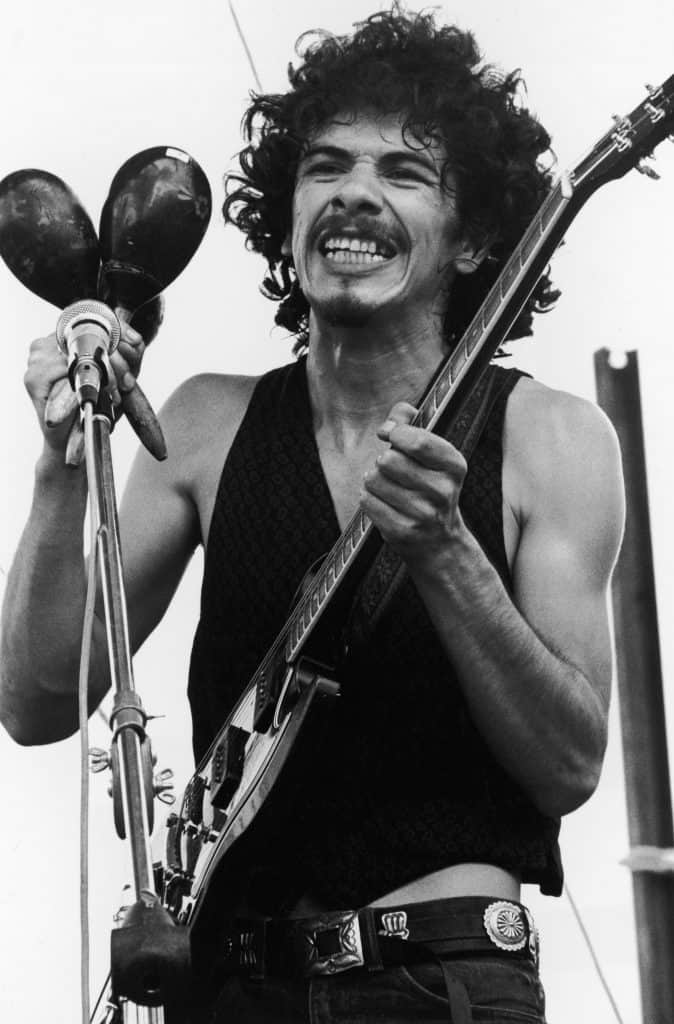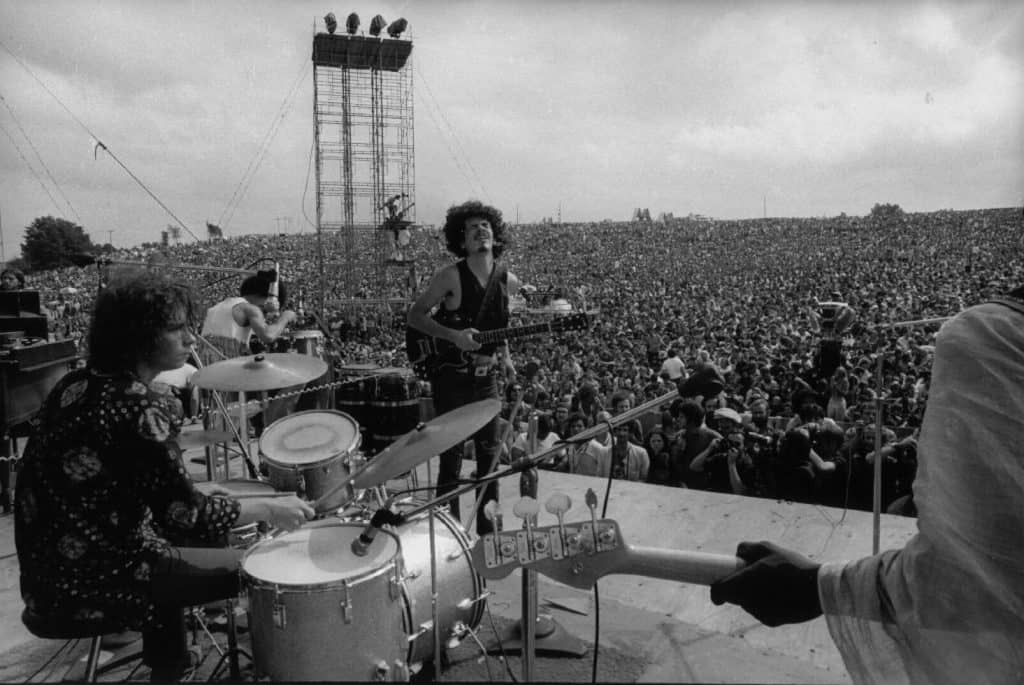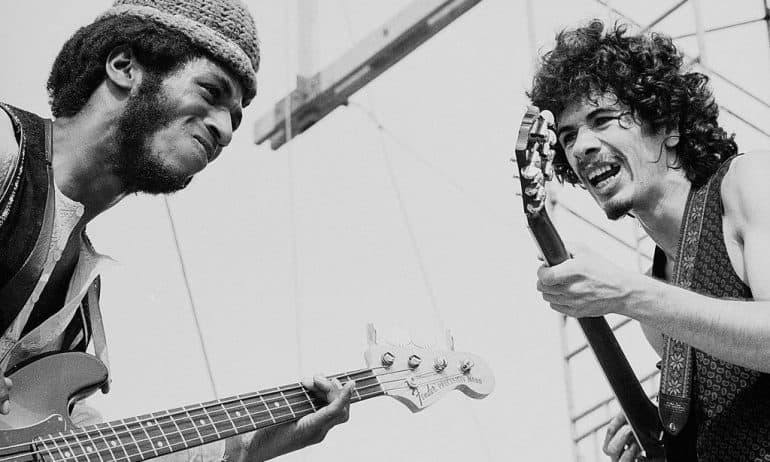When you think of iconic performances, Santana at Woodstock surely tops the list. If it doesn’t then you must be doing life wrong. For most of us, Woodstock in itself is a dream or a memory that we wish we could have. For the people who actually went to Woodstock, I’m sure you love opening with it at parties presuming that you can remember at least half of it.
So for us lesser-beings who weren’t graced with the pleasure, we think music, psychedelics, and Santana, and we’re not half wrong. For all Nixon’s politics, Woodstock was a reminder that music can quite adequately separate oneself from a trying time.
Despite, or in spite of, all the LSD and mind-expanding substances, the rest of us are reluctantly happy to feed on the scraps of ’60s music presented to us not least by Woodstock.
If you were a musician in the ’60s, Woodstock was the festival to play, it separated the boys from the men and the girls from the women. If you were in a band in the ’60s and didn’t play Woodstock, I can hear you kicking yourself.
Santana Woodstock
At Woodstock, Santana’s performance was nothing if not iconic. Santana showed the popular music world that Latin music was something to be appreciated. At Woodstock, the eponymous Carlos Santana, Gregg Rolie, Jose Areas, Mike Carabello, Michael Shrieve, and David Brown, in 1969, put their collective musical hearts on the line and music duly took a welcome punch in the gut.
Admittedly, they were out of their minds on psychedelics, but it didn’t stop their musical greatness from spreading to the rest of the world.

Santana’s performance was a perfect summation of the ’60s. Good vibes, good tunes, and a short-lived escape from the possibility of being called up to the Vietnam War.
If you haven’t seen or heard the footage of Santana’s set at Woodstock then do yourself a favor. It was a more than stellar performance despite the mass amount of psychedelics that were inevitably imbibed.
In the mid to late ’60s, San Francisco was a boiling pot for the hippie movement. Enough long hair to make your granddad feel uneasy, visions of peace and love, and a healthy or unhealthy amount of psychedelics, depending on how you view the world, were at the beating heart of a cultural change. Oh, and between all the peace and love, some pretty sublime music came out of it too.
As a dishwasher before forming Santana, Carlos was clearly in the wrong game. Other than maybe banging a few pots and pans together and saying, “Hey, that’s a nice beat,” not much musically could be gained for Carlos. That’s not a slight on the dishwasher’s union of the world, but maybe one of you is the next Carlos Santana? Stranger things have happened.
Three years prior to Woodstock In 1966, enough was enough, and Santana was born. Before Woodstock, Santana was a relatively unknown act. Santana had only graced the local venues of San Francisco but had yet set the world on fire with their lysergic fusion of Latin-rock.
It was a perfectly unrealized mixture of just the right amount of blues-rock, which was experiencing a boom in the form of white kids emulating the blues originals like Robert Johnson and Muddy Waters, combined with Latin music that was otherwise mostly unheard of in popular music at that point.
Santana had a vision, though little did they know that it would soon be on its way to becoming globally acknowledged and appreciated.

It wasn’t long before Santana caught the attention of Bill Graham, an esteemed promoter and rock and roll entrepreneur who saw the potential of Latin infused rock agreed to manage them. After convincing the promoters of Woodstock to feature Santana on the bill, history was set in motion.
Santana had yet released an album, and yet here they were set to play one of the biggest if not the biggest gig in music history. Of course, nobody could’ve known how iconic the festival would later become, but when the bill features Hendrix, Janis Joplin, the Grateful Dead, and Jefferson Airplane, to name but a few, it’s probably wise to bring your a-game. Or you could take a hallucinogen and you know, see what happens…
When you’re fending off your guitar because you think it might be a snake, you know that something has either gone terribly right or terribly wrong for you, again, depending on how you view the world.
Santana arrived at Woodstock at eleven in the morning and was told that they would go on at eight in the evening. “Fair enough,” they presumably and collectively said, “that’ll give us just the right amount of time to get high,” and so it happened.
Backstage the group met with Jerry Garcia – meetings with Jerry Garcia seldom end in sobriety. Not excepting the rule, Garcia was something of a generous heart with his supply of hallucinogenics. In Carlos’ autobiography, The Universal Tone he stated,
“I took it right away… I was thinking, I’ll have time to enjoy this, come back down, drink a lot of water, get past the amoeba state and be ready to play tonight. No problem. Right.”
Because the world is a cruel mistress, after taking the hallucinogenic, Santana was told that they had to go on at two rather than eight, so a tripped out Santana went out to what was probably a field of goats.
Thankfully, the heavy dosage did not affect Santana, at least musically, mentally who knows? The jury’s out. The six took to the stage like they born to do it, and as we know, they were.
Santana Soul Sacrifice
Fusing their Latin influences with the blues, Santana was a notable surprise to the crowd due to their somewhat unknown status as a group.
Not that they would’ve known, but Santana’s set consisted of “Waiting,” “Evil Ways,” “You Just Don’t Care,” “Savor,” “Jingo,” “Persuasion,” “Fried Neckbones and Some Home Fries.” and a thoroughly spellbinding eleven-minute version of, “Soul Sacrifice.”
With onstage improvisation, it’s likely that you can lose your band and lose your audience, but Santana’s Woodstock performance was a testament to a master-class of onstage energy. At no given time was the set too self-indulgent.
It was experimental and yet engaging. Musically technical but also appealing enough to not be solely resigned to the exclusive jazz enthusiasts smoking their pipes in the crowd.
For Carlos Santana, Woodstock and their set was a culmination of everything the 1960s aspired to be. A youthful exercise in protest and peace. He told the New York Times that Woodstock was a place where,
“You get to smoke pot and you get to hear congas, and music that makes you celebrate [and] not think about fear or Vietnam or Nixon or whatever.”
For Carlos, he saw a place where, “people can get along, with unity and harmony… that’s why we’re still talking about Woodstock, man.”
Clearly, he put a smiley face on Woodstock and Santana’s performance. Whether you deem it the conversation of a snake charming god trite hippie nonsense or not, what can’t be denied is that Woodstock set Santana’s proverbial wheels into motion.
Along with what I presume would’ve been a monumental hangover, Santana awoke the next day to a torrent of acknowledgment and commercial awareness. It wasn’t just the brown acid munching goers of Woodstock that had felt the prelude of what Santana would become, but also the wider world intent on hearing something fresh and original within the realms of rock.
Months after Woodstock, Santana released their self-titled LP. They immediately scored a top ten hit with, “Evil Ways,” and the rest, as they say, was history. Woodstock had struck a chord with just about every rock-lover across the world, and here was a group ready to soak up their deserving praise.
Of course, with great responsibility comes great power. Because rock bands are intrinsically doomed to, “creative differences,” the original Woodstock line-up soon went awry. But the iconic Woodstock performance was at least a blueprint for what Santana would become.
So, what have we learned from Santana’s iconic performance at Woodstock? For one, fending off an imaginary snake may not necessarily be a bad thing when it comes to your ambitions of being a legendary guitarist, and two, God takes many forms, but one of them just happens to be Carlos Santana.
On a serious note, Santana’s performance proved that the world was waiting for an original band to take two disparate genres of rock and Latin music and fuse them together to unleash them in a way that had never been previously heard.
Carlos Santana and Santana has and will inspire every generation to come. Just know that it all started at the legendary festival of Woodstock.
Similar Stories…
Betty Davis – The Revolutionary Funk Singer Ahead of Her Time
- The Alice Cooper Fact Sheet – 5 Things You Need To Know - January 12, 2023
- Everybody Knows The Words, But What Is Hotel California About? - April 29, 2022
- What Is The Meaning Of Stairway To Heaven: Led Zeppelin’s Amazing 1971 Musical Epic? - April 24, 2022


